 (1)
(1)
摘要 传统无差拍直接转矩磁链控制(DB-DTFC)策略应用于五相永磁同步电机(PMSM)时存在稳态性能差、转矩和磁链耦合、谐波电流大等问题,该文提出一种改进型DB-DTFC策略。首先,为实现转矩和磁链的解耦控制,在两相静止坐标系中对定子电压与转矩和磁链之间的关系进行分析,求解满足控制要求的电压矢量。其次,设计电流和磁链观测器补偿数字控制系统的延时。再次,采用基于4个非零电压矢量的空间矢量脉宽调制(SVPWM)技术,抑制相电流的3次谐波分量。实验结果表明,该策略计算简便,抑制了转矩和磁链脉动,降低了3次谐波电流,提升了控制系统动稳态性能。
关键词:无差拍控制 直接转矩和磁链控制 永磁同步电机(PMSM) 延时补偿 空间矢量脉宽调制(SVPWM)
与三相永磁同步电机(Permanent Magnet Syn- chronous Motor, PMSM)相比,以五相PMSM为代表的多相电机驱动系统由于拥有更多的控制自由度、较小的母线电流纹波、更高的母线电压利用率等优点,在电动汽车、舰船驱动等领域得到广泛关注[1-3]。
直接转矩控制(Direct Torque Control, DTC)和矢量控制(Vector Control, VC)是工业生产中最常用的PMSM控制策略。相比于VC[4-5],DTC以转矩和磁链作为控制变量,采用滞环比较器和开关表相结合的方式实现对电机的控制,具有结构简单、动态响应速度快等特点[6-8]。然而,传统DTC无法精确识别转矩和磁链误差的大小,在单一控制周期内输出单一电压矢量,因此存在转矩和磁链脉动大、电流谐波含量高等缺点。模型预测转矩控制(Model Predictive Torque Control, MPTC)依据价值函数最小化原则,从有限控制集中选择最优电压矢量[9-11],提升了转矩和磁链动态响应能力。然而,MPTC存在迭代计算复杂、权重系数调整困难等缺点。无差拍直接转矩和磁链控制(Deadbeat Direct Torque and Flux Control, DB-DTFC)策略以电机模型为基础,在一个控制周期内以消除转矩和磁链误差为目标求解电压矢量,控制系统结构简单、无需多余参数整定,因此受到广泛关注。文献[12]基于定子磁链差分法和PMSM复功率提出了两种简化的DB-DTFC策略,提高了稳态性能、降低了计算量,但动态性能有待提升。文献[13]提出一种用于三相PMSM的基于两相同步旋转坐标系(dq)的传统DB-DTFC策略,提升了转矩和磁链的稳态性能。然而其无差拍模型不理想、定子电压求解复杂。另外,其未考虑大误差情况下电压限制带来的长调节时间问题。文献[14]将文献[13]策略与最小时间斜坡轨迹法相结合,充分利用逆变器电压求解转矩变化率最大的定子电压,以提高响应的快速性和稳定性。然而该策略运算繁琐,计算量会随着误差值的增大而增加。文献[15-16]提出了一种基于定子磁链定向的DB- DTFC策略,该策略根据转矩误差控制负载角的变化实现无差拍控制,实现了转矩和磁链的独立调节,提高了稳态和动态性能。然而,不合适的参考磁链会对磁链控制精度产生较大影响,严重时可能导致控制系统不稳定。另外,在设计无差拍系统时通常假设控制变量的采样和计算同时发生。然而,由于数字控制系统存在时间延迟,会引起振荡现象。此外,电机运行过程中存在参数摄动和外部扰动,需要对这些扰动进行估计以提高系统鲁棒性能[17-19]。
为实现对转矩和磁链的精确控制,提高电机的稳态和动态性能。本文针对五相PMSM,提出一种改进型DB-DTFC策略。首先,为解决转矩和磁链之间的耦合问题,根据ab 坐标系上的PMSM数学模型,分析电压矢量对转矩和磁链变化的影响,求解合适的定子电压矢量。其次,为解决数字系统的延时问题,设计观测器对电流、磁链和转矩进行预测。最后,采用空间矢量脉宽调制(Space Vector Pulse Width Modulation, SVPWM)合成目标电压矢量以抑制3次谐波电流。
假设五相PMSM仅含基波反电动势,忽略定子绕组间互感和漏感,则该电机在ab 坐标系上的数学模型可表示为
 (1)
(1)
 (2)
(2)
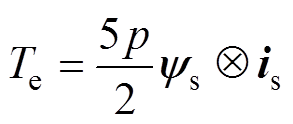 (3)
(3)
式中,us=[usausb]T、ys=[ysaysb]T、is=[isa isb]T、yr= [yfcosqr yfsinqr]T分别为定子电压、磁链、电流和永磁磁链;usa, usb、ysa, ysb、isa, isb、yfcosqr, yfsinqr分别为us、ys、is、yr在a、b 轴上的分量;Rs为定子电阻;yf为永磁磁链的幅值;Te为电磁转矩;p为极对数;Ls为电感;qr为转子位置角。
定子磁链ys的幅值及相位可分别表示为
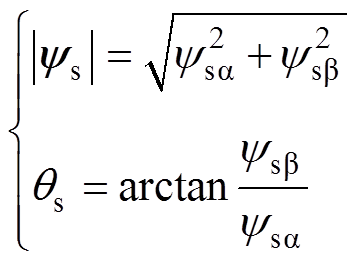 (4)
(4)
为了分析电压矢量对电机转矩的影响,由式(3)求得转矩变化率为
 (5)
(5)
将式(1)和式(2)代入式(5),可得
 (6)
(6)
假设:①每个控制周期内非零电压矢量的作用时间为Tk,其取值范围为0≤Tk≤Ts;②在剩余的控制周期Ts-Tk中作用零矢量。根据该假设,一个控制周期内转矩变化量可表示为
 (7)
(7)
 (8)
(8)
其中
 (9)
(9)
 (10)
(10)
式中,d为电压矢量和永磁磁链矢量的夹角;wr为转子电角速度。假设所有变量在每个控制周期内保持恒定,则在一个控制周期内转矩误差可表示为
 (11)
(11)
为了精确控制定子磁链,使其在每个控制周期结束时达到给定值。对式(1)进行离散化,可得
 (12)
(12)
忽略定子电阻,由于零电压矢量对定子磁链基本无影响,定子磁链的变化取决于非零电压矢量及其作用时间。因此,式(12)可进一步表示为
 (13)
(13)
在此基础上,根据图1定子磁链增量计算,在一个控制周期内定子磁链误差可表示为
 (14)
(14)
式中,g 为电压矢量和定子磁链矢量的夹角。相比于其他项,|us(k)Tk|2很小,可忽略不计。因此,在一个控制周期内磁链的误差可进一步表示为
 (15)
(15)

图1 定子磁链增量计算
Fig.1 Calculation of stator flux increment
基于上述分析,为了实现转矩和磁链的无差拍控制,k时刻所作用电压矢量应同时消除式(11)和式(15)所表示的转矩和磁链误差值,电压矢量选择如图2所示。图中,正多边形表示逆变器的输出电压极限,由于五相PMSM需考虑谐波抑制,采用SVPWM所能调制电压的最大值umax为正多边形的内切圆半径。

图2 电压矢量选择
Fig.2 Graphical representation of voltage vector selection
因此,联立式(11)和式(15)求解参考电压矢量。为了改善系统的动态响应能力,将|us(k)|设置为umax。最终解得参考电压矢量相位as及每个控制周期的作用时间Tk分别为
 (16)
(16)
 (17)
(17)
其中
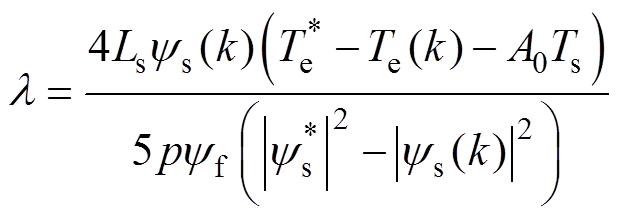 (18)
(18)
由此,k时刻定子电压可表示为
 (19)
(19)
根据上述分析,为消除转矩误差,电压矢量的最小作用时间需要Tk。电机运行时磁链会有微小变化,通过修正as可保证磁链控制精度,进而实现转矩和定子磁链控制的独立性。相较于传统DB- DTFC,所提策略计算更为简便,电压矢量对转矩和磁链实现了解耦控制,提升了转矩和磁链的跟踪性能,进而保证电机优越的稳态和动态性能。
在数字控制系统中,控制变量的采样周期超前控制周期会造成一拍延时问题。因此,通过设计观测器预测下一控制周期的定子电流和磁链,以实现无差拍控制。
定子电压和磁链在d、q轴上的分量可表示为
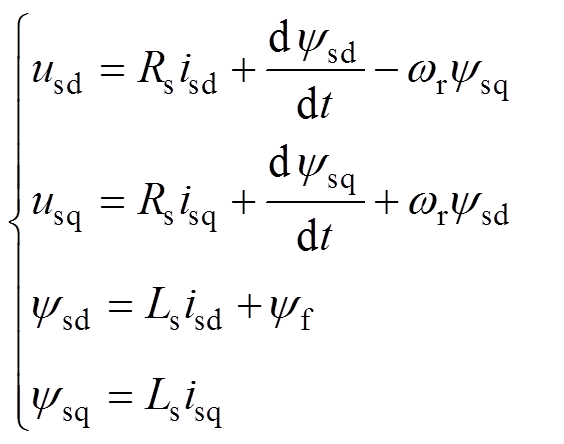 (20)
(20)
式中,usd, usq、isd, isq、ysd, ysq分别为us、is、ys在d、q轴上的分量。在电机运行时,Rs、Ls、yf等参数发生变化会产生扰动电压Dudq。设计如图3所示的PI控制器对这部分电压进行补偿。根据式(20),k+1时刻的定子电流可表示为
 (21)
(21)

图3 定子电流观测器
Fig.3 Stator current observer
k+1时刻的转子位置角可根据其与转子电角速度之间的关系求得,有
 (22)
(22)
经坐标变换将dq中k+1时刻电流转换到ab 中,有
 (23)
(23)
定子磁链估计采用电压模型和电流模型两者相结合的观测器。采用式(2)表示的电流模型计算k时刻的定子磁链为
 (24)
(24)
由于零矢量对磁链几乎没有影响,结合式(1)的电压模型,k+1时刻的定子磁链可表示为
 (25)
(25)
由此,可得k+1时刻的电磁转矩为
 (26)
(26)
五相PMSM运行时,根据电压源逆变器中功率器件的开关状态,可获得如图4所示的30个非零矢量和2个零矢量,其中非零矢量根据幅值不同分为大、中、小矢量,其幅值分别为0.647 2Udc、0.4Udc、0.247 2Udc。其中,Udc为直流母线电压[20-22]。

图4 五相PMSM空间电压矢量
Fig.4 Space voltage vectors of five-phase PMSM
为抑制3次谐波电流,在基波空间中每个扇区内选取2个大矢量和中矢量合成参考电压矢量。根据空间电压矢量分布特点,在基波空间中当同相位的大矢量作用时间为中矢量作用时间的1.618倍时,对应3次谐波空间内合成电压矢量为零。由此,在ab 空间合成的电压矢量幅值最大为

 (27)
(27)
以第一扇区为例,选取非零矢量V25、V16、V24、V29和零矢量V0参与矢量合成。根据伏秒平衡原理,如图5所示合成参考电压矢量为
 (28)
(28)
其中
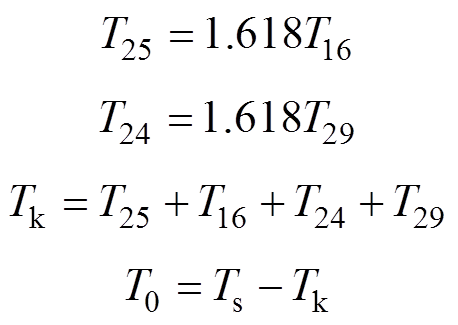
式中,Vref1为基波空间中参考电压矢量;T25、T16、T24、T29、T0分别为一个PWM周期内上述各电压矢量的作用时间。

图5 第一扇区相邻4个非零电压矢量合成
Fig.5 Voltage vector synthesis of adjacent four none-zero vectors in sector Ⅰ
根据上述分析,提出用于五相PMSM驱动系统的改进型DB-DTFC策略,该系统控制框图如图6所示。
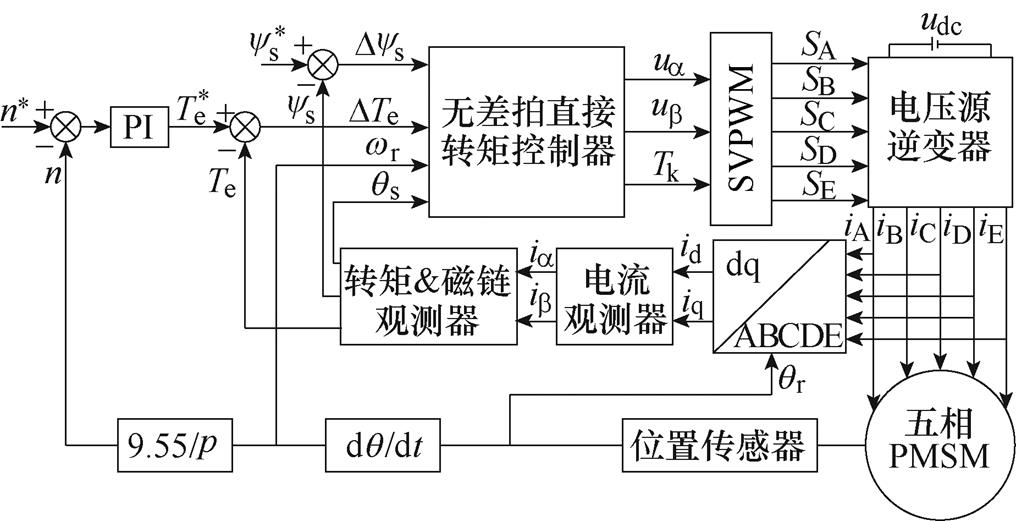
图6 改进型DB-DTFC控制框图
Fig.6 Control diagram of improved DB-DTFC
搭建如图7所示的实验平台,验证本文所提出的改进型DB-DTFC策略的可行性,并与文献[13]中传统DB-DTFC策略进行对比。五相PMSM参数见表1。控制器以TMS320F2812芯片和PM100CVA120功率模块为核心,转矩传感器型号为YH502,永磁直流电机连接功率电阻作为负载。

图7 实验平台
Fig.7 Experimental platform
表1 电机参数
Tab.1 Motor parameters

参 数数 值 槽数20 极对数11 额定转速/(r/min)300 额定电流/A14.14 相电感/mH1.43 相电阻/W0.3 永磁磁链/Wb0.030 6
为了保证对比实验的公平性和合理性,传统DB-DTFC策略和所提出的改进型DB-DTFC策略都采用本文所设计的基于相邻4个非零电压矢量的SVPWM技术。电机转速设置为300 r/min,负载转矩给定为4 N·m。电机稳态实验波形及定子磁链矢量在ab 平面的轨迹分别如图8、图9所示。可见,传统DB-DTFC和改进型DB-DTFC的转矩脉动分别为11.1%和7.8%。在两种策略控制下,均能较好地控制定子磁链,其在ab 平面上的轨迹接近圆形。传统DB-DTFC的相电流波形一定程度上发生了畸变,而改进型DB-DTFC的相电流波形较为光滑。因此,所提出的改进型DB-DTFC策略能在保持磁链控制精度的基础上更好地抑制转矩脉动。图10为两种策略控制下A相电流的快速傅里叶变换(Fast Fourier Transformation, FFT)。可见,传统DB-DTFC和改进型DB-DTFC下的A相电流总谐波畸变率(Total Harmonic Distortion, THD)分别为10.48%和5.46%。因此,改进型DB-DTFC具有更好的电流谐波抑制能力。主要原因是改进型DB-DTFC策略所求解电压矢量更符合无差拍控制目标,对定子磁链和转矩控制精度较高,因此电流谐波较小。图11为两种策略控制下基波空间和3次谐波空间的电流波形。可见,相比传统DB-DTFC策略,改进型DB-DTFC策略的基波空间电流波形呈现较好的正弦度,且3次谐波空间中的电流几乎被抑制为零。两种控制策略的稳态性能对比见表2。可见,相比传统DB-DTFC策略,所提出的改进型DB-DTFC策略不但减少了计算量,而且能更好地抑制转矩和磁链脉动,降低相电流谐波,具有更好的稳态性能。

(a)传统DB-DTFC
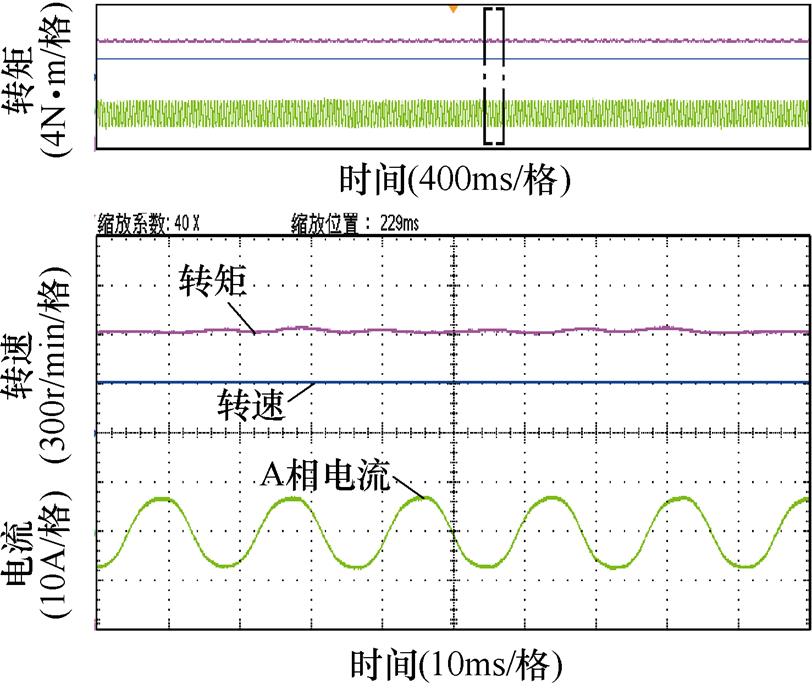
(b)改进型DB-DTFC
图8 稳态实验结果对比
Fig.8 Comparison of steady-state experimental results
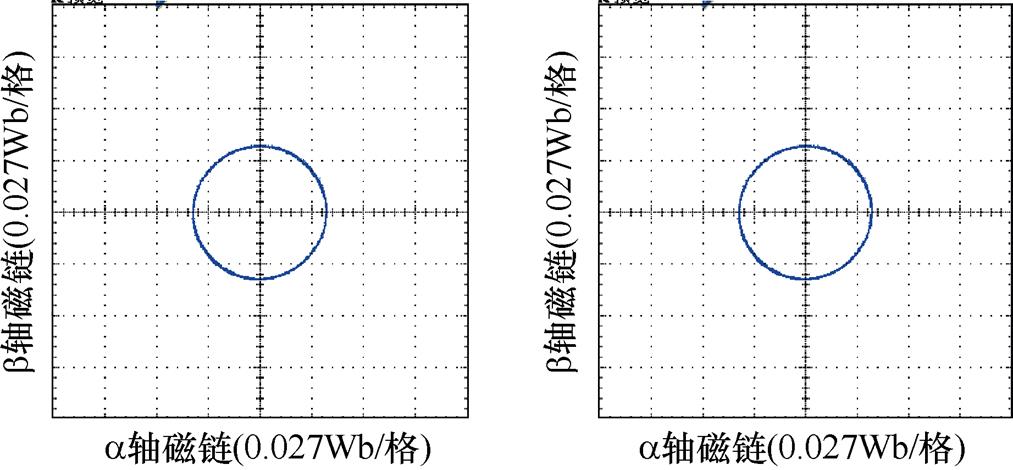
(a)传统DB-DTFC (b)改进型DB-DTFC
图9 定子磁链矢量在ab 平面上的轨迹对比
Fig.9 Trajectory comparison of stator flux vector in absubspace

图10 A相电流FFT对比分析
Fig.10 FFT comparative analysis of phase-A current
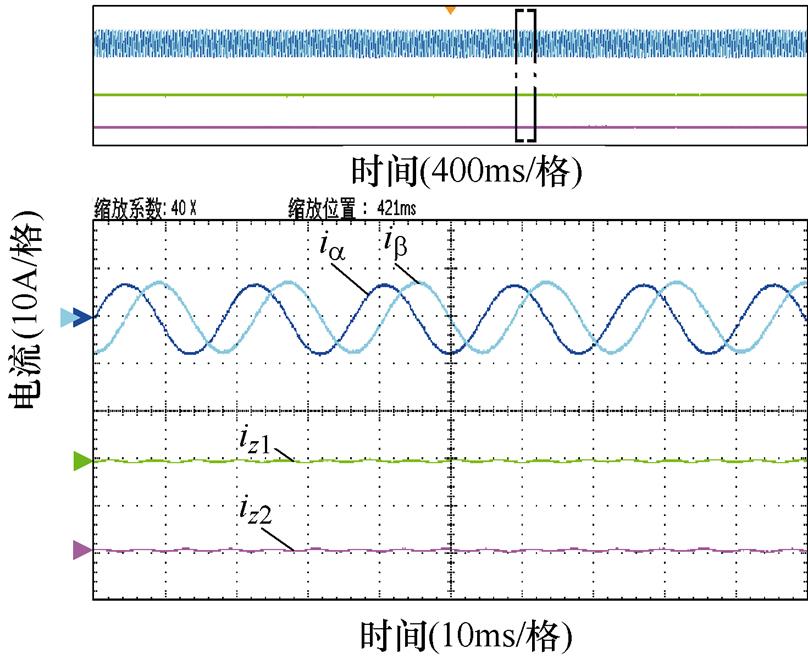
(a)传统DB-DTFC
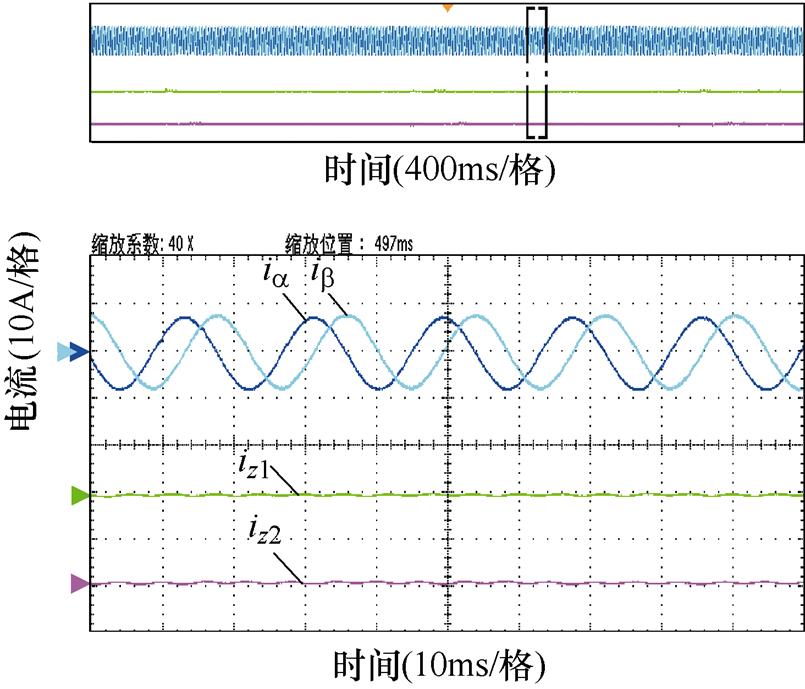
(b)改进型DB-DTFC
图11 ab 和z1z2坐标系下的电流波形
Fig.11 Current waveforms in ab and z1z2 subspaces
表2 稳态性能对比
Tab.2 Comparison of steady-state performance

转矩脉动(%)磁链脉动(%)电流THD(%)计算时间/ms 改进型DB-DTFC7.84.255.469.8 传统DB-DTFC11.15.5110.4815.3
为了进一步验证在改进型DB-DTFC策略下PMSM的动态性能,电机进行了负载阶跃和转速阶跃实验。电机参考转速为300 r/min,负载转矩在4 N·m和6 N·m之间发生阶跃。图12、图13分别为传统DB-DTFC和改进型DB-DTFC转速、转矩、磁链和电流的动态响应波形。负载阶跃变化时的响应时间和最大转速波动见表3。可见,在两种策略控制下电机均能在较短时间内对负载变化做出响应,且改进型DB-DTFC响应更迅速。传统DB-DTFC由于磁链和转矩存在耦合,在负载阶跃变化过程中,转速产生较大波动、调节时间较长,且转矩在此过程出现振荡,定子磁链误差增大,极大地影响了转矩变化后的稳态性能。相比之下,由于改进型DB- DTFC实现了转矩和磁链的解耦,在负载变化过程中,转速波动较小,调节时间较短,且转矩响应更为平稳、迅速,磁链幅值在此过程中基本保持不变,控制精度不因负载变化而降低。
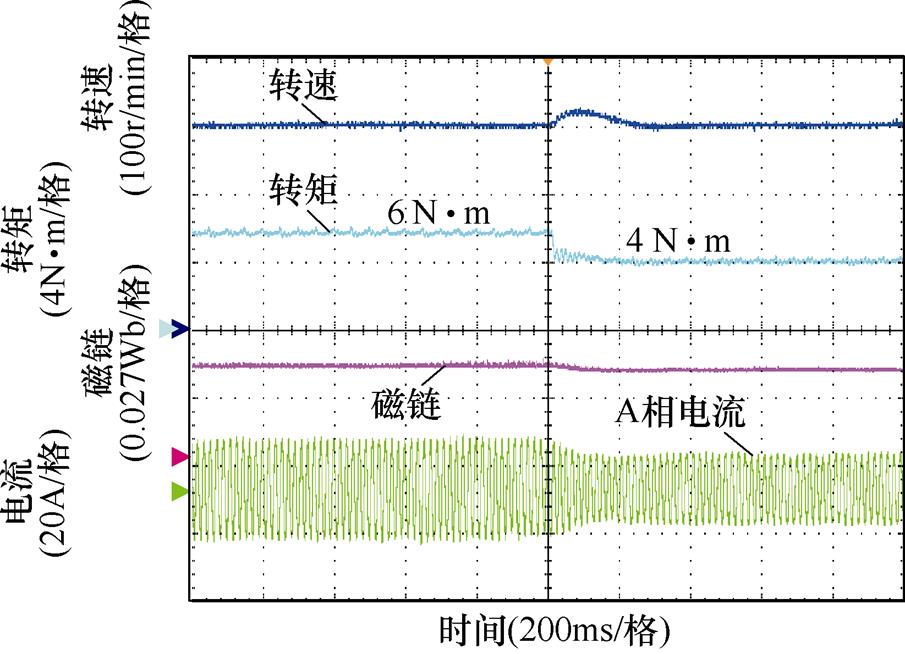
(a)负载向下阶跃
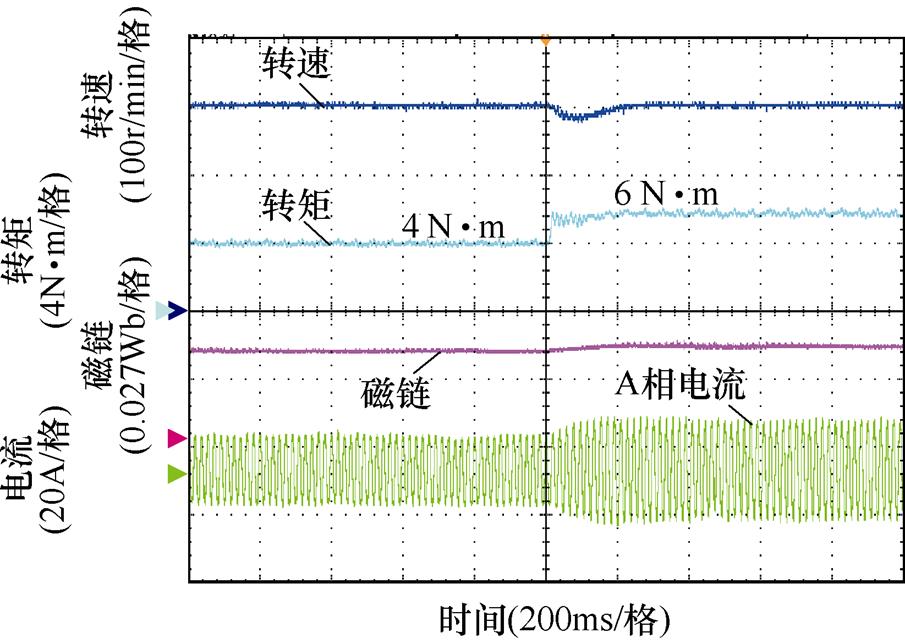
(b)负载向上阶跃
图12 传统DB-DTFC负载阶跃实验结果
Fig.12 Experimental results of traditional DB-DTFC when load step changes
图14、图15分别为电机参考转速在200 r/min和300 r/min之间阶跃时,传统DB-DTFC和改进型DB-DTFC转矩、转速和电流的动态响应波形。可见,当参考转速向下和向上阶跃时,若采用传统DB- DTFC策略,电机转速响应时间分别为182 ms和195 ms;当采用改进型DB-DTFC时,电机转速响应时间分别为162 ms和165 ms。因此,所提出的改进型DB-DTFC策略对于转速变化的响应更为迅速。

(a)负载向下阶跃

(b)负载向上阶跃
图13 改进型DB-DTFC负载阶跃实验结果
Fig.13 Experimental results of improved DB-DTFC when load step changes
表3 动态性能对比
Tab.3 Comparison of dynamic performance
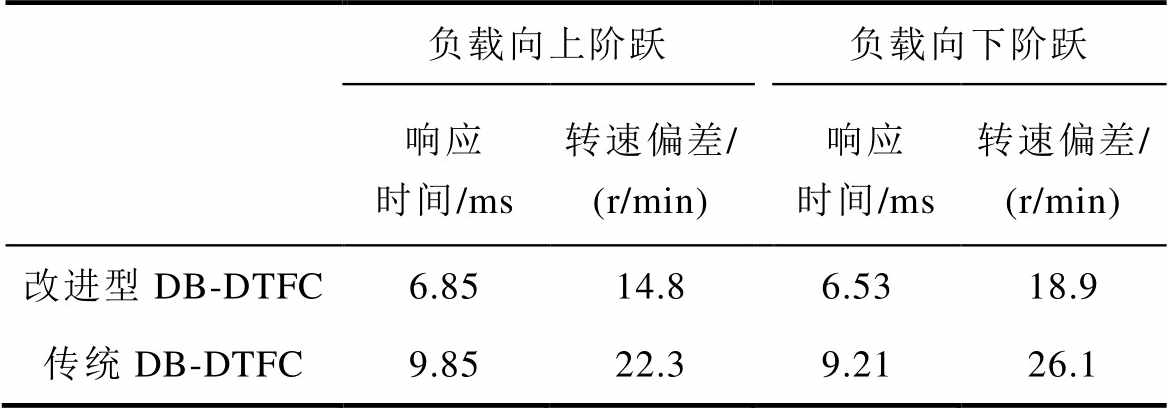
负载向上阶跃负载向下阶跃 响应时间/ms转速偏差/ (r/min)响应时间/ms转速偏差/ (r/min) 改进型DB-DTFC6.8514.86.5318.9 传统DB-DTFC9.8522.39.2126.1

(a)转速向下阶跃
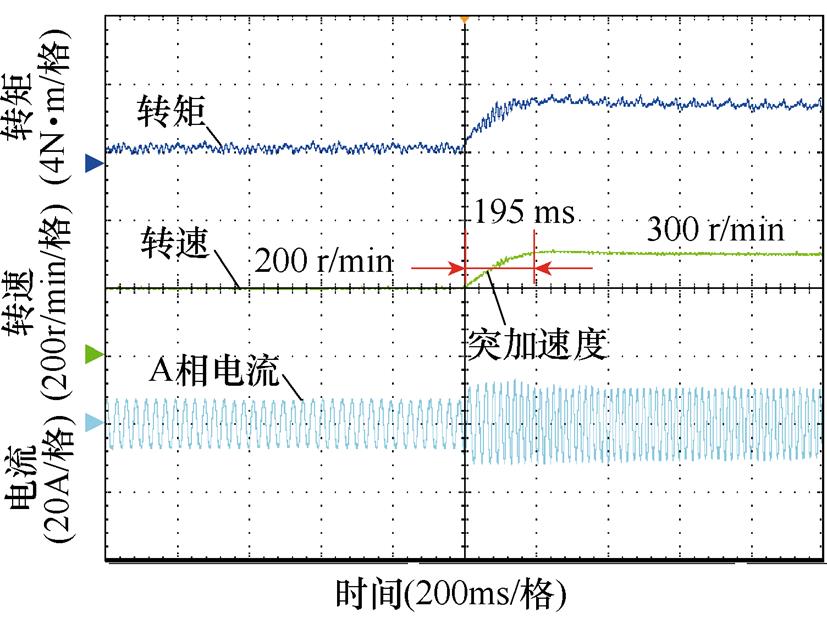
(b)转速向上阶跃
图14 传统DB-DTFC转速阶跃实验结果
Fig.14 Experimental results of traditional DB-DTFC when speed step changes
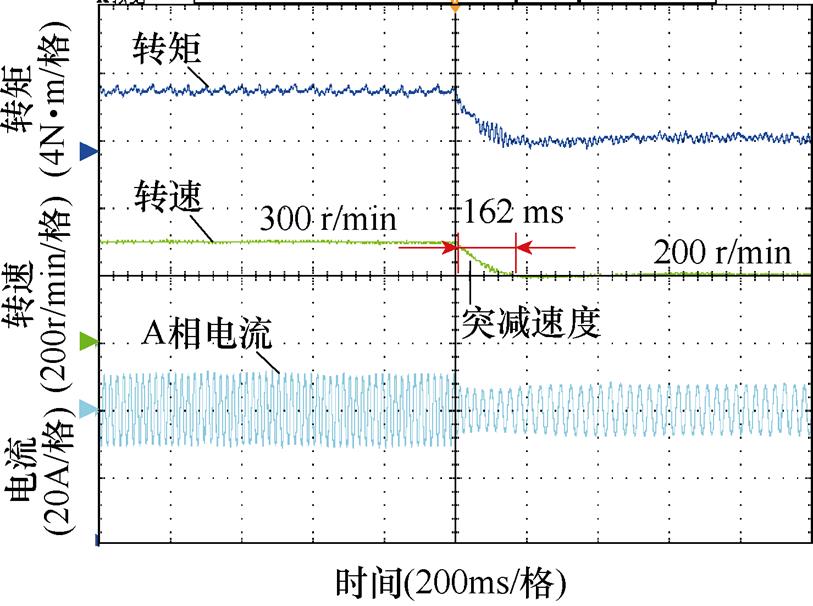
(a)转速向下阶跃
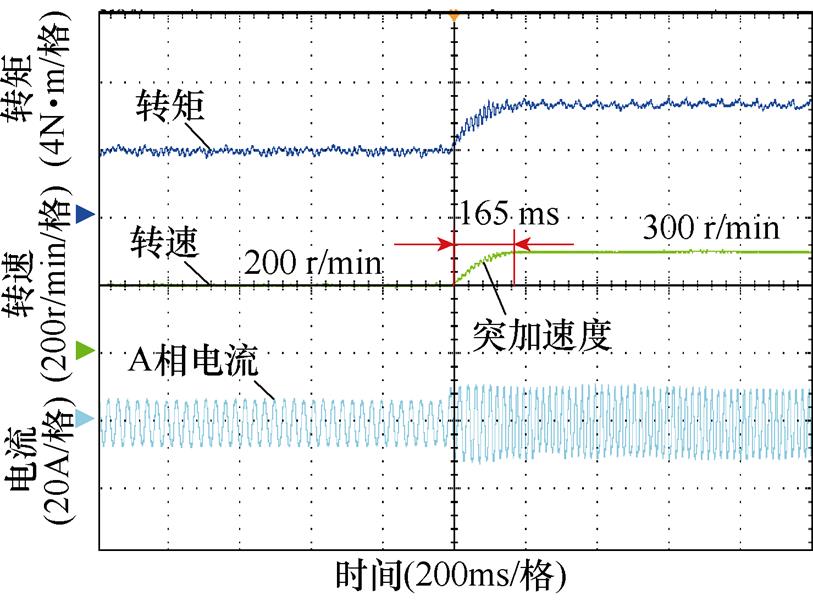
(b)转速向上阶跃
图15 改进型DB-DTFC转速阶跃实验结果
Fig.15 Experimental results of improved DB-DTFC when speed step changes
通过上述对比实验,相较于传统DB-DTFC,改进型DB-DTFC在稳态时可更好地控制转矩、磁链和电流,减小稳态误差;在动态过程中,实现了转矩和磁链的解耦控制,对电机运行状态变化具备更好的跟踪性能,对负载扰动和参数扰动具有更快的响应速度,提高了系统稳定性。综上所述,本文所提出改进型DB-DTFC策略具有更为优越的动态性能。
本文针对五相PMSM提出一种改进型DB- DTFC策略。所提策略具有如下优点:
1)相较于传统DB-DTFC策略,该策略定子电压求解更为简单,降低了CPU计算负担。
2)该策略建立的转矩和磁链控制模型更为精确,实现了转矩和磁链的解耦控制,在稳态时产生更小的转矩和磁链脉动,提高了控制精度,改善了系统的稳态和动态性能。
3)设计观测器解决数字控制的延时问题,且一定程度上提升了系统的参数鲁棒性。
4)采用基于相邻4个非零电压矢量的SVPWM有效抑制了3次谐波电流,降低了相电流的畸变率。
参考文献
[1] Zhou Huawei, Xu Jinhui, Chen Cheng, et al. Disturbance-observer-based direct torque control of five-phase permanent magnet motor under open- circuit and short-circuit faults[J]. IEEE Transactions on Industrial Electronics, 2021, 68(12): 11907-11917.
[2] 王震宇, 孙伟, 蒋栋. 基于虚拟电压注入的闭环磁链观测器的感应电机无速度传感器矢量控制系统[J]. 电工技术学报, 2022, 37(2): 332-343.
Wang Zhenyu, Sun Wei, Jiang Dong. Induction motor speed sensorless vector control system based on closed-loop flux observer with virtual voltage injection[J]. Transactions of China Electrotechnical Society, 2022, 37(2): 332-343.
[3] 李修东, 郑晓钦, 王海峰, 等. 最大转矩范围内九相永磁同步电机缺相容错运行铜耗优化策略[J]. 电工技术学报, 2022, 37(17): 4355-4363.
Li Xiudong, Zheng Xiaoqin, Wang Haifeng, et al. Copper consumption optimization strategy of nine- phase permanent magnet synchronous motor under fault-tolerant operation in the maximum torque range[J]. Transactions of China Electrotechnical Society, 2022, 37(17): 4355-4363.
[4] 高宏伟, 杨贵杰, 刘剑. 3次谐波注入式五相永磁同步电机矢量控制策略[J]. 中国电机工程学报, 2014, 34(24): 4101-4108.
Gao Hongwei, Yang Guijie, Liu Jian. A vector control strategy for five-phase PMSM with third harmonic injection[J]. Proceedings of the CSEE, 2014, 34(24): 4101-4108.
[5] Li Jianhua, Du Bochao, Zhao Tianxu, et al. Current sensor fault-tolerant control for five-phase PMSM drives based on third-harmonic space[J]. IEEE Transactions on Industrial Electronics, 2022, 69(10): 9827-9837.
[6] 黄林森, 赵文祥, 吉敬华, 等. 稳态性能改善的双三相永磁电机直接转矩控制[J]. 电工技术学报, 2022, 37(2): 355-367.
Huang Linsen, Zhao Wenxiang, Ji Jinghua, et al. Direct torque control for dual three-phase permanent- magnet machine with improved steady-state perfor- mance[J]. Transactions of China Electrotechnical Society, 2022, 37(2): 355-367.
[7] 陈浩, 和阳, 赵文祥, 等. 基于占空比调制的五相容错永磁游标电机直接转矩控制[J]. 电工技术学报, 2020, 35(5): 1055-1064.
Chen Hao, He Yang, Zhao Wenxiang, et al. Direct torque control of five-phase fault-tolerant permanent magnet vernier motor based on duty cycle modu- lation[J]. Transactions of China Electrotechnical Society, 2020, 35(5): 1055-1064.
[8] Choi Y S, Choi H H, Jung J W. Feedback lineari- zation direct torque control with reduced torque and flux ripples for IPMSM drives[J]. IEEE Transactions on Power Electronics, 2016, 31(5): 3728-3737.
[9] 李祥林, 薛志伟, 阎学雨, 等. 基于电压矢量快速筛选的永磁同步电机三矢量模型预测转矩控制[J]. 电工技术学报, 2022, 37(7): 1666-1678.
Li Xianglin, Xue Zhiwei, Yan Xueyu, et al. Voltage vector rapid screening-based three-vector model predictive torque control for permanent magnet synchronous motor[J]. Transactions of China Elec- trotechnical Society, 2022, 37(7): 1666-1678.
[10] 赵勇, 黄文新, 林晓刚, 等. 基于权重系数消除和有限控制集优化的双三相永磁容错电机快速预测直接转矩控制[J]. 电工技术学报, 2021, 36(1): 3-14.
Zhao Yong, Huang Wenxin, Lin Xiaogang, et al. Fast predictive direct torque control of dual three-phase permanent magnet fault tolerant machine based on weighting factor elimination and finite control set optimization[J]. Transactions of China Electro- technical Society, 2021, 36(1): 3-14.
[11] Huang Wentao, Hua Wei, Fan Qigao. Performance analysis and comparison of two fault-tolerant model predictive control methods for five-phase PMSM drives[J]. CES Transactions on Electrical Machines and Systems, 2021, 5(4): 311-320.
[12] Wang Wusen, Liu Chunhua, Zhao Hang, et al. Improved deadbeat-direct torque and flux control for PMSM with less computation and enhanced robustness[J]. IEEE Transactions on Industrial Electronics, 2023, 70(3): 2254-2263.
[13] Lee J S, Choi C H, Seok J K, et al. Deadbeat-direct torque and flux control of interior permanent magnet synchronous machines with discrete time stator current and stator flux linkage observer[J]. IEEE Transactions on Industry Applications, 2011, 47(4): 1749-1758.
[14] Lee J S, Lorenz R D. Deadbeat-direct torque and flux control of IPMSM drives using a minimum time ramp trajectory method at voltage and current limits[C]// 2013 IEEE Energy Conversion Congress and Expo- sition, Denver, CO, USA, 2013: 1778-1785.
[15] Lin Xiaogang, Huang Wenxin, Jiang Wen, et al. Deadbeat direct torque and flux control for permanent magnet synchronous motor based on stator flux oriented[J]. IEEE Transactions on Power Electronics, 2020, 35(5): 5078-5092.
[16] 刘国海, 刘凯旋, 周华伟, 等. 基于定子磁链定向的五相PMSM新型无差拍直接转矩和磁链控制[J]. 中国电机工程学报, 2022, 42(16): 6073-6082, 6181.
Liu Guohai, Liu Kaixuan, Zhou Huawei, et al. Novel deadbeat direct torque and flux control of five-phase PMSM based on stator flux orientation[J]. Pro- ceedings of the CSEE, 2022, 42(16): 6073-6082, 6181.
[17] 秦艳忠, 阎彦, 陈炜, 等. 永磁同步电机参数误差补偿-三矢量模型预测电流控制[J]. 电工技术学报, 2020, 35(2): 255-265.
Qin Yanzhong, Yan Yan, Chen Wei, et al. Three- vector model predictive current control strategy for permanent magnet synchronous motor drives with parameter error compensation[J]. Transactions of China Electrotechnical Society, 2020, 35(2): 255-265.
[18] 章回炫, 范涛, 边元均, 等. 永磁同步电机高性能电流预测控制[J]. 电工技术学报, 2022, 37(17): 4335-4345.
Zhang Huixuan, Fan Tao, Bian Yuanjun, et al. Predictive current control strategy of permanent magnet synchronous motors with high performance[J]. Transactions of China Electrotechnical Society, 2022, 37(17): 4335-4345.
[19] Zuo Yuefei, Mei Jie, Jiang Chaoqiang, et al. Digital implementation of deadbeat-direct torque and flux control for permanent magnet synchronous machines in the M-T reference frame[J]. IEEE Transactions on Power Electronics, 2021, 36(4): 4610-4621.
[20] 薛诚, 宋文胜, 冯晓云. 五相永磁同步电机多目标优化直接转矩控制算法[J]. 中国电机工程学报, 2016, 36(6): 1695-1704.
Xue Cheng, Song Wensheng, Feng Xiaoyun. A direct torque control algorithm of five-phase permanent- magnet machines with multi-objective optimization[J]. Proceedings of the CSEE, 2016, 36(6): 1695-1704.
[21] Suhel S M, Maurya R. A new switching sequences of SVPWM for six-phase induction motor with features of reduced switching losses[J]. CES Transactions on Electrical Machines and Systems, 2021, 5(2): 100- 107.
[22] 朱琳, 卜飞飞, 黄文新, 等. 五相逆变器非正弦双随机空间矢量脉宽调制策略[J]. 电工技术学报, 2018, 33(20): 4824-4833.
Zhu Lin, Bu Feifei, Huang Wenxin, et al. Non- sinusoidal dual random space vector pulse width modulation strategy for five-phase inverter[J]. Transactions of China Electrotechnical Society, 2018, 33(20): 4824-4833.
An Improved Deadbeat Direct Torque and Flux Control Strategy of Five-Phase Permanent Magnet Synchronous Motor
Abstract With the advantages of higher bus voltage utilization and more degrees of control freedom, multiphase permanent magnet synchronous motors (PMSMs) are widely used in electric vehicles, ship propulsion, and other fields. Direct torque control (DTC) and vector control (VC) are the most popular methods. Compared with VC, DTC needs two hysteresis comparators of stator flux linkage and torque and a switching table, which has a simple structure and fast dynamic response. However, traditional DTC has the disadvantages of large torque, flux linkage ripples, and high current harmonics. Model predictive torque control (MPTC) selects the optimal voltage vector from a control set according to the cost function to improve the torque and flux dynamic response. It has heavy computational burden and difficulty in tuning the weighting factor. Deadbeat direct torque and flux control (DB-DTFC) can eliminate the errors of torque and flux linkage within one sampling period by a voltage vector, which is obtained by discretizing the mathematical model. In addition, its control structure is simple, and it is unnecessary to adjust redundant parameters. However, there is a coupled relationship between torque and stator flux linkage. The traditional DB-DTFC has poor dynamic and steady-state performance. Therefore, an improved DB-DTFC strategy is proposed for five-phase PMSM.
Firstly, the PMSM model is discretized in the two-stationary frame, and a voltage vector is obtained from the relationship among stator voltage, torque, and stator flux linkage. Thus, the decoupling control of torque and stator flux linkage can be achieved. Secondly, current and flux linkage observers are built to compensate for delay and parameter disturbance in the digital control system. Finally, due to harmonic space in the five-phase PMSM, the space vector pulse width modulation (SVPWM) based on four non-zero vectors is designed to restrain the third harmonic current.
Experimental results of the traditional and improved DB-DTFC were tested at rated speed to evaluate the steady-state performance. Compared with the traditional DB-DTFC, the improved DB-DTFC can better suppress the torque and flux linkage ripples, the waveform of phase current is more sinusoidal, and the CPU execution time is shorter. Therefore, the voltage vector obtained by the improved DB-DTFC is more consistent with the deadbeat control goal, improving the stator flux and torque control accuracy and restraining current harmonics. Moreover, during dynamic experiments, the improved DB-DTFC has faster torque and speed responses, shorter adjustment time, and more dynamic response than the traditional DB-DTFC, ensuring the control accuracy of flux linkage.
The effectiveness of the proposed strategy is verified through theoretical analysis and experiments, and the following conclusions can be drawn. (1) Compared with the traditional DB-DTFC, the stator voltage of the method is much easier to obtain, thus requiring less computation. (2) The model of torque and flux linkage is accurate to achieve the decoupling control. The ripples are less at steady-state operation, thus improving the steady-state and dynamic performance. (3) Current and flux linkage observers are designed to eliminate the delay of digital control and to improve the parameter robustness. (4) SVPWM based on four non-zero vectors can effectively restrain the third harmonic current and reduce the distortion of phase current.
keywords:Deadbeat control, direct torque and flux control (DTFC), permanent magnet synchronous motor (PMSM), delay compensation, space vector pulse width modulation (SVPWM)
中图分类号:TM351
DOI: 10.19595/j.cnki.1000-6753.tces.221730
国家自然科学基金(52277052)和江苏高校“青蓝工程”资助项目。
收稿日期 2022-09-13
改稿日期 2022-11-09
刘国海 男,1964年生,教授,博士生导师,研究方向为电机控制、复杂系统控制及非线性智能控制等。E-mail: ghliu@ujs.edu.cn
周华伟 男,1980年生,教授,博士生导师,研究方向为电动汽车和电磁悬架用特种永磁电机驱动控制、容错控制等。E-mail: zhouhuawei@ujs.edu.cn(通信作者)
(编辑 崔文静)